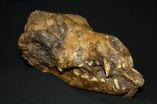(Press-News.org) A Curtin University researcher has shown that ancient volcanic eruptions in Australia 510 million years ago significantly affected the climate, causing the first known mass extinction in the history of complex life.
Published in prestigious journal Geology, Curtin's Associate Professor Fred Jourdan, along with colleagues from several Australian and international institutions, used radioactive dating techniques to precisely measure the age of the eruptions of the Kalkarindji volcanic province.
Dr Jourdan and his team were able to prove the volcanic province occurred at the same time as the Early–Middle Cambrian extinction from 510-511 million years ago – the first extinction to wipe out complex multicellular life.
"It has been well-documented that this extinction, which eradicated 50 per cent of species, was related to climatic changes and depletion of oxygen in the oceans, but the exact mechanism causing these changes was not known, until now," Dr Jourdan said.
"Not only were we able to demonstrate that the Kalkarindji volcanic province was emplaced at the exact same time as the Cambrian extinction, but were also able to measure a depletion of sulphur dioxide from the province's volcanic rocks – which indicates sulphur was released into the atmosphere during the eruptions.
"As a modern comparison, when the small volcano Pinatubo erupted in 1991, the resulting discharge of sulphur dioxide decreased the average global temperatures by a few tenths of a degree for a few years following the eruption.
"If relatively small eruptions like Pinatubo can affect the climate just imagine what a volcanic province with an area equivalent to the size of the state of Western Australia can do."
The team then compared the Kalkarindji volcanic province with other volcanic provinces and showed the most likely process for all the mass extinctions was a rapid oscillation of the climate triggered by volcanic eruptions emitting sulphur dioxide, along with greenhouse gases methane and carbon dioxide.
"We calculated a near perfect chronological correlation between large volcanic province eruptions, climate shifts and mass extinctions over the history of life during the last 550 million years, with only one chance over 20 billion that this correlation is just a coincidence," Dr Jourdan said.
Dr Jourdan said the rapid oscillations of the climate produced by volcanic eruptions made it difficult for various species to adapt, ultimately resulting in their demise. He also stressed the importance of this research to better understand our current environment.
"To comprehend the long-term climatic and biological effects of the massive injections of gas in the atmosphere by modern society, we need to recognise how climate, oceans and ecosytems were affected in the past," he said.
INFORMATION:
The paper's abstract, High-precision dating of the Kalkarindji large igneous province, Australia, and synchrony with the Early–Middle Cambrian (Stage 4) extinction, is available at: http://geology.gsapubs.org/content/early/2014/04/22/G35434.1.abstract. A full version is available on request.
Australia's deadly eruptions the reason for the first mass extinction
2014-05-30
ELSE PRESS RELEASES FROM THIS DATE:
X-ray pulses on demand from electron storage rings
2014-05-30
Everything we know nowadays about novel materials and the underlying processes in them we also know thanks to studies at contemporary synchrotron facilities like BESSY II. Here, relativistic electrons in a storage ring are employed to generate very brilliant and partly coherent light pulses from the THz to the X-ray regime in undulators and other devices. However, most of the techniques used at synchrotrons are very "photon hungry" and demand brighter and brighter light pulses to conduct innovative experiments. The general greed for stronger light pulses does, however, ...
Glow-in-the-dark tool lets scientists find diseased bats
2014-05-29
Scientists working to understand the devastating bat disease known as white-nose syndrome (WNS) now have a new, non-lethal tool to identify bats with WNS lesions —ultraviolet, or UV, light.
If long-wave UV light is directed at the wings of bats with white-nose syndrome, it produces a distinctive orange-yellow fluorescence. This orange-yellow glow corresponds directly with microscopic skin lesions that are the current "gold standard" for diagnosing white-nose syndrome in bats.
"When we first saw this fluorescence of a bat wing in a cave, we knew we were on to something," ...
Police reform law underenforced by Department of Justice
2014-05-29
CHAMPAIGN, Ill. — A law designed to combat police misconduct is hamstrung by limited resources, a lack of transparency and "political spillover" at the U.S. Department of Justice, says a recently published empirical study by Stephen Rushin, a law professor at the University of Illinois and expert in criminal law and policing.
In 1994, Congress passed 42 U.S.C. Section 14141 as part of the Violent Crime Control and Law Enforcement Act, granting the U.S. attorney general the power to initiate structural reform litigation against local police departments engaged in a pattern ...
Powerful tool combs family genomes to find shared variations causing disease
2014-05-29
(SALT LAKE CITY)—Scientists at the University of Utah (U of U), the University of Texas MD Anderson Cancer Center in Houston and colleagues have developed a powerful tool called pVAAST that combines linkage analysis with case control association to help researchers and clinicians identify disease-causing mutations in families faster and more precisely than ever before.
In a study in Nature Biotechnology, the researchers describe cases in which pVAAST (the pedigree Variant Annotation, Analysis and Search Tool) identified mutations in two families with separate diseases ...
Ecosystem services: Looking forward to mid-century
2014-05-29
(Santa Barbara, Calif.) — As population grows, society needs more — more energy, more food, more paper, more housing, more of nearly everything. Meeting those needs can lead to changes in how land is used.
Native grasslands, forests and wetlands may be converted into croplands, tree plantations, residential areas and commercial developments. Those conversions can, in turn, diminish the health of natural ecosystems and their ability to provide an array of valuable services, such as clean air and water, wildlife and opportunities for recreation, to name a few.
In two ...
Study: Baltimore hookah bars contain elevated levels of carbon monoxide and air nicotine
2014-05-29
Smoking waterpipes, or hookahs, creates hazardous concentrations of indoor air pollution and poses increased risk from diminished air quality for both employees and patrons of waterpipe bars, according to a new study from the Institute for Global Tobacco Control at the Johns Hopkins Bloomberg School of Public Health. In an analysis of air quality in seven Baltimore waterpipe bars, researchers found that airborne particulate matter and carbon monoxide exceeded concentrations previously measured in public places that allowed cigarette smoking and that air nicotine was markedly ...
Solar panel manufacturing is greener in Europe than China, study says
2014-05-29
Solar panels made in China have a higher overall carbon footprint and are likely to use substantially more energy during manufacturing than those made in Europe, said a new study from Northwestern University and the U.S. Department of Energy's Argonne National Laboratory. The report compared energy and greenhouse gas emissions that go into the manufacturing process of solar panels in Europe and China.
"We estimated that a solar panel's carbon footprint is about twice as high when made in China and used in Europe, compared to those locally made and used in Europe," said ...
Study links unexpected death of a loved one with onset of psychiatric disorders
2014-05-29
May 29, 2014 -- The sudden loss of a loved one can trigger a variety of psychiatric disorders in people with no history of mental illness, according to researchers at Columbia University's Mailman School of Public Health and colleagues at Columbia's School of Social Work and Harvard Medical School. While previous studies have suggested there is a link between sudden bereavement and an onset of common psychiatric disorders, this is the first study to show the association of acute bereavement and mania in a large population sample. Findings are published online in the American ...
Domestication of dogs may explain mammoth kill sites and success of early modern humans
2014-05-29
A new analysis of European archaeological sites containing large numbers of dead mammoths and dwellings built with mammoth bones has led Penn State Professor Emerita Pat Shipman to formulate a new interpretation of how these sites were formed. She suggests that their abrupt appearance may have been due to early modern humans working with the earliest domestic dogs to kill the now-extinct mammoth -- a now-extinct animal distantly related to the modern-day elephant. Shipman's analysis also provides a way to test the predictions of her new hypothesis. Advance publication of ...
NASA widens 2014 hurricane research mission
2014-05-29
VIDEO:
During this year's Atlantic hurricane season, NASA is redoubling its efforts to probe the inner workings of hurricanes and tropical storms with two unmanned Global Hawk aircraft flying over storms...
Click here for more information.
During this year's Atlantic hurricane season, NASA is redoubling its efforts to probe the inner workings of hurricanes and tropical storms with two unmanned Global Hawk aircraft flying over storms and two new space-based missions.
NASA's ...






